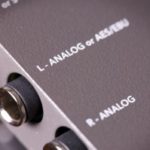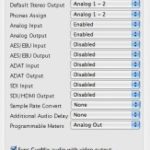
REVIEW – Sound Devices 788T Location Sound Recorder
Posted on Mar 30, 2010 by Alex Fice
Sound Devices 788T Sound RecorderI’m not sure how Sound Devices can be so convinced that they’re contenders in the location disc recorder market. After all, the new 788T isn’t much bigger than a hard-back book, has simple controls, a single, small LCD and a few dozen LEDs. Its competitors, in contrast, are either as portable as the Reichstag or appear to have been styled by Dr. Hans Zarkov and must, therefore, be more serious pieces of kit. Surely.
Well, sarcasm aside, the 788T does pack a lot into a rather small and neat package. It’s baby brother, the four track 744T has been around for a while and it totally fantastic, but there is a lot more to the 788T than just twice as many inputs (spot the naming convention).
Inputs and Outputs
The eight audio inputs can be mic or line level or AES/EBU digital. The mic pre-amps have a useful 76dB of gain and excellent limiters with programmable threshold, recovery time and hard or soft knee. They are analog limiters but are controlled digitally by the on-board DSP, which works very well indeed.
Analog inputs 1-4 are on XLRs with inputs 5-8 on TA3 connectors – used extensively on Sound Devices equipment to keep the designs small. The digital inputs are on a 15-pin mini D-type connector, so you need a break-out cable. There are some digital microphones on the market (like the Schoeps CMD-2U powering module) that need ‘digital phantom power’ which the 788T can provide. Inputs can be linked into stereo pairs. There are four balanced, line level outputs, again on TA3s and a couple more unbalanced on a 3.5mm jack, along with two AES/EBU balanced outputs (i.e. four channels) on TA3s. All the outputs can be assigned to any input or recording track so, for instance, you could send a mix-down to the Director’s headphone feed. There are 3.5mm and ¼in jack sockets, usually used for phones, but these can also be routed to any inputs or tracks, so with a little creative cabling you can get eight analog outputs.
The 788T syncs to pretty much anything with wordclock in and out, video sync in (PAL, NTSC and HD tri-level) and excellent timecode support on a standard Lemo connector. You can also sync multiple Sound Devices hard disc recorders together with a proprietary connector – this also carries transport controls, so synchronised units will all record and play back together. Finally, the internal hard disc is accessible over Firewire (400 or 800) or USB 2 – there is a USB keyboard connector as well to make it easier name or rename recordings, enter metadata and so on.
Storage
The 788T ships with an internal 160GByte, 5400rpm, SATA-5 laptop drive which you can replace without voiding the warranty, providing the job is done by a ‘qualified technician’ – whatever that means. The hardware is able to record twelve tracks to disc in either multiple monophonic, or single polyphonic BWF files (you can play back MP2s and MP3s too, but not record them). A built in disc speed test will determine if your CF cards and external discs are able to handle the data bandwidth for all twelve tracks. It’s worth noting that the unit’s sample rates are 32, 44.1, 47.952, 48 and 48.048kHz (at 16 or 24 bit) – no 96kHz here. Personally, I’m fine with that limitation for a location recorder, but I’m sure someone will complain that they want to use up their disc space at twice the rate for no readily apparent (or audible) reason. The AES/EBU inputs will accept up to 192kHz signals with the on-board sample rate converters enabled. The Firewire ports can be used to connect an external hard disc or optical drive with the 788T as the master, so you don’t need a computer to burn your dailies to DVD. An external hard disc could be used as a redundant backup, recording simultaneously to the internal drive, or directly as your deliverable medium. If you don’t like the idea of your expensive discs being lost by the post-production house, there is a Compact Flash card slot in the back of the 788T, which can also make recordings on its own or in parallel with the internal disc. In fact, you can record simultaneously to internal disc, external Firewire disc and the CF card, though, if you use all three, performance drops to only eight-track recording.
Eight of the twelve record tracks (A-H) are pre-fade (but, obviously, post trim, HPF and limiter) and so would generally be used to record the eight inputs directly. Two more tracks are called L and R and are intended as a stereo mix – they are always post-fader (more on track routing and mixing later). The final two tracks, X1 and X2, can be either pre or post-fade. Any input can be routed to any record track and routing more than one input to a record track effectively creates a mix.
That’s a pretty flexible spec. for such a compact unit, but flexibility can be more of a problem than a benefit, as some of the clunky competitors to the 788T show. Somehow, though, Sound Devices manage to provide a user interface that is fast and easy to use, with simple menus and a minimum of controls. I’m not going to go through everything the 788T can do – you can download the manual from Sound Devices’ website www.sounddevices.com – but let’s have a look at setting up and using the unit.
Operation
It’ll come as no surprise that pressing the Menu button brings up the main menu on the LCD. The quickest way to navigate the menus is using the knob on the right side of the unit – turning scrolls through items; press to select. One of the best features of the menu structure is the ability to lay ‘breadcrumbs’. Basically, any menu item can be marked as a favourite, then you can hop from favourite to favourite at the touch of a button, instead of having to scroll through the whole menu. It’s best to keep your breadcrumbs to a minimum – I stick with things that are essential on location – changing file name prefixes so I can differentiate between slates and wild tracks, for instance.
Before the shoot, you just need to go through the menus and set up sample rates and word sizes, the timecode format, output routing and so on. There is a very flexible disc structure – I tend to place all my recordings in a sub-directory called RECORDINGS (imaginative) and set the 788T to automatically generate a further sub-directory each day. That way, when I mount the disc from my laptop (why does that sound so rude?) I can easily identify that day’s recordings.
That flexibility extends to naming conventions for files. The recommended format is SxxxTyyy.wav where xxx is the slate number and yyy is the take number. The take number is automatically incremented each Record/Stop, and can be automatically reset to 1 when you change slate number. It’s a simple two button combination to increment the slate number. Of course, when you don’t get told that the slate has changed, it’s easy to rename files. You can store your own custom filename prefixes on disc, so I usually set up a WILD prefix and an ATMOS prefix so I can quickly jump from recording slates to either of these.
The Record button overrides pretty much any operation – you can be deep in a menu, hit record and the unit drops whatever it is you were doing and starts recording. There is a pre-record buffer so you can set the unit up to start recording up to ten seconds before you press the record button – a useful, if now common, feature.
Routing
Once the basic configuration for your shoot is set up, you won’t need to access the main menus much, the front panel controls and the rotary encoder knob cover 99% of on-location requirements.
Simply turn an input on by popping out the trim knob and turning up the gain – there’s a click detent at minimum gain that physically turns off the input circuitry to increase battery life. Between each pair of trim knobs is a momentary toggle switch. Push it to the left and it calls up the input display for the upper (odd) input – to the right for lower (even). By default, the front panel ‘trim’ knob is actually the channel fader – trim is controlled by the side rotary – though the optional CL-8 fader panel gives you better faders, in which case you use the front panel controls for trim. The input display shows you both trim and fader gain (alternating) and the Menu, HDD, Tone, Brightness and transport controls become soft keys for the various input functions. Very fast. Very intuitive. Very cool. Tap the play soft key and the display expands to let you route the selected input to any of the record tracks. That’s full control of inputs and routing without having to delve into any of the menus. Nice.
Next you need to arm tracks for recording. Hit the Input button on the front panel and the display will show you all the record tracks (with meters). Simply select a track with the rotary and click to toggle record enable. Press the levels soft key (the Play button again) and you can control the gain of your master and aux track stereo pairs. It’s as simple as that.
Displays
There are eight channels of LED meters for the record tracks – you need to toggle the second bank of four to see all twelve tracks. This is the only annoying limitation that’s been imposed by the 788T’s small form format, but I can live with it. A nicer feature is the LED ring around each input trim knob. This pulses green when there is a signal on the input, yellow when that input’s limiter engages, flashes red on peaks and is solid red if the input is muted.
The main display is full of useful information – timecode, recording format, disc space and so on. Again, whilst the display is small, it manages to show you what you need to know clearly and concisely. The display backlight is white under normal circumstances, green when you are in playback, and red when recording.
Price
The Sound Devices 788T is a truly fantastic field disc recorder. At £5250 plus £949 for the CL-8, it’s not a small investment (the prices have just rocketed up due to the sad state of the pound) but the street price is lower and, anyway, it’s cheaper than most of the serious competition. In many applications, it will take the place of both recorder and mixer.
Sound quality and build quality are both excellent – though there is a plastic cover over the LCD which had become marked on the review unit – just a slight annoyance and easily replaced. The 788T comes with a standard 7.2v Sony battery (4600mAh) which won’t keep you running all day, so you’ll need to invest in more batteries.
Above all, it’s the sheer attention to detail, common to most Sound Devices products, that I love about the 788T and it’s smaller sibling. They work just how you want them to work – there is none of the clunky, clumsiness of their rivals. Their timecode support is excellent (a troubling weakness in cheaper recorders) and they are incredibly reliable – I’ve had a 744T for a couple of years and have never lost a recording or had a crash on set. If you are worried about recording to hard drives, Sound Devices have just announced the 788T-SSD which replaces the internal hard disc with a 256GByte solid-state drive.













